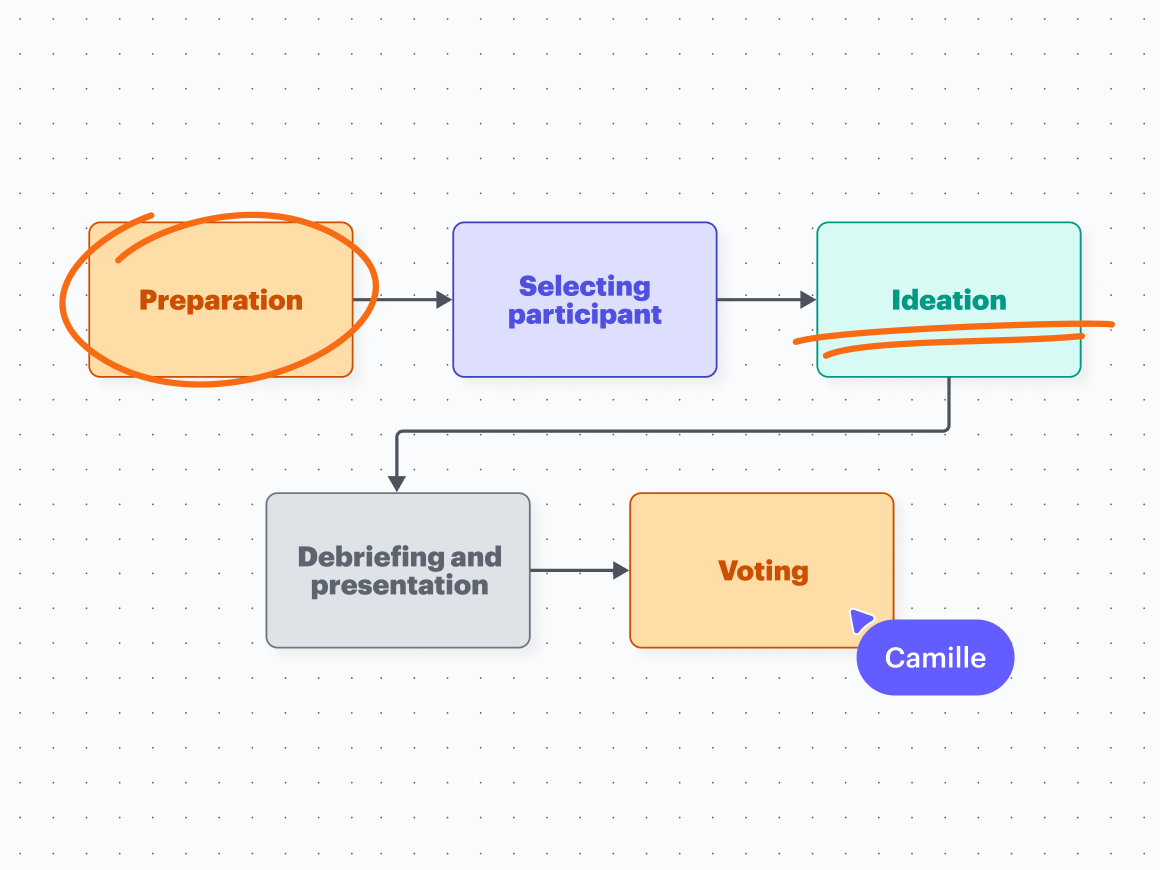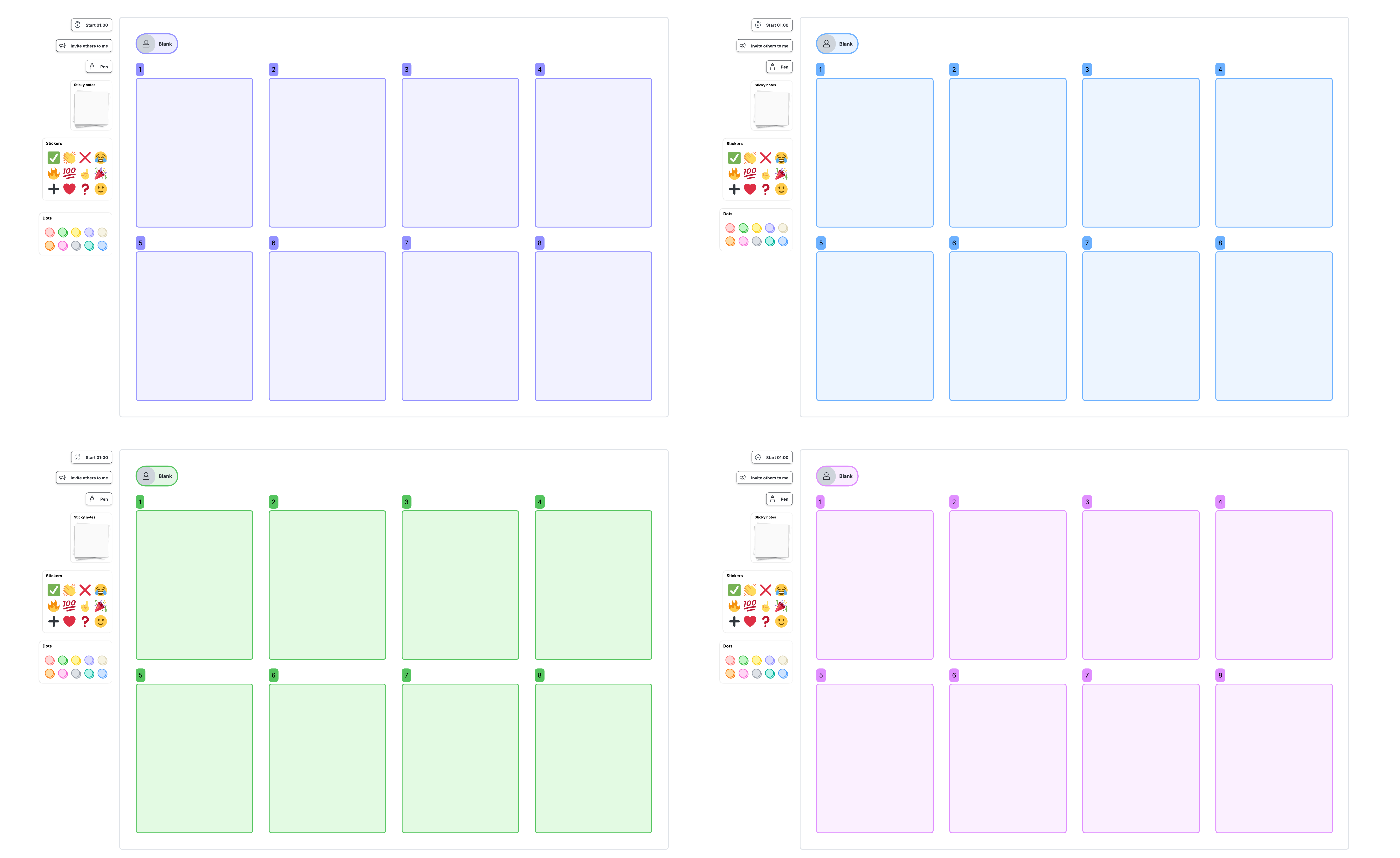Key takeaways
-
The crazy eights brainstorming method is an efficient way to generate many ideas in a short amount of time.
-
There are five steps in crazy eights brainstorming: preparing, selecting participants, ideating, debriefing and presenting, and voting.
-
To maximize the benefits after your brainstorming session, follow up to set your ideas in motion.
Genuine innovation can feel ambiguous in today’s work landscape. In hybrid working environments, successful brainstorming is more than choosing the right collaboration software; it's about how you leverage your ideas. Teams use many techniques for brainstorming, but one of the most efficient ways to turn good ideas into actionable next steps is with the crazy eights method.
This powerful design thinking technique uses a structured brainstorming approach to generate ideas more effectively. It's ideal for product development, UX, design, and marketing teams that need to solve problems quickly and creatively.
This article will explain the steps for hosting a crazy eights brainstorm to spark engagement and deliver results regardless of where team members work from.
What is the crazy eights brainstorming method?
Crazy eights is part of the design thinking and design sprint process. This rapid idea technique challenges participants to quickly generate ideas to solve a problem. Each person has eight frames on a canvas, getting only one minute to brainstorm new ideas for each. This pushes teams to think of more creative, unconventional solutions.
Benefits of the crazy eights brainstorming method
This technique facilitates divergent thinking, generating a wider range of ideas efficiently and inclusively.
The main benefits of the crazy eights method are that it is straightforward and efficient. It welcomes collaboration and focus by only giving participants eight minutes to think of ideas. It removes the pressure of sharing polished ideas so that everyone can feel comfortable getting their thoughts out on the canvas. It also utilizes freehand drawing to encourage inspiration and creativity.
In-text CTA: Learn about the five stages of design thinking. Read now
5 steps for a crazy eights brainstorming session

-
Preparing
The first step to a successful crazy eights brainstorming session is proper preparation. To help you define the scope of your session, ask yourself the following questions:
-
What is the problem that I am trying to solve?
-
What deliverables do we need?
-
Will rapid idea generation help inspire possible solutions?
-
What is the overall goal of this brainstorm?
If you’re using Lucid to facilitate this session, you can prepare your board ahead of time and share it with all participants. Even people who don’t have Lucid can still participate as Guest Collaborators.
We have a free crazy eights template that you can use and customize to your liking.

-
Selecting participants
Next, select who will participate in the ideation session. Ideally, your group would consist of six to eight people. When groups are too large, they can become overwhelming. Smaller group work helps hold team members accountable and makes them feel valued in the discussion.
-
Ideating
After completing the preparatory steps, you’re ready to begin your session. We recommend using Lucid’s infinite canvas to host the session. It gives you access to facilitation tools that streamline the brainstorming session and make it easier to lead the group.
Set a timer for one minute. Ask your team to begin sketching in the first section and stop when the timer goes off. Note that each team member should have their own set of eight frames. Repeat this eight times until each frame is filled out. Remember that the goal is to be quick; don’t spend too much time thinking about what you’re brainstorming. Moving past the obvious ideas first will help uncover more innovative solutions in the following frames.
-
Debriefing and presentation
Now it's time for team members to share their ideas. You can use the sort feature, which automatically sorts and categorizes your ideas based on common themes. You can have AI summarize your ideas, or if you’d rather, each person can discuss what they wrote or drew individually.
-
Voting
Once ideas have been presented, it's time to vote. Set up a quick voting session and have people select their top ideas. Then, see which ideas are the most popular.
In less than 10 minutes, your team will have generated dozens of ideas. But don’t stop there. Follow up on the brainstorm to ensure the session’s value is fully realized. Set project goals, assign tasks, and map out your action plan.

Explore more brainstorming techniques to generate winning ideas.
Read moreAbout Lucid
Lucid Software is the leader in visual collaboration and work acceleration, helping teams see and build the future by turning ideas into reality. Its products include the Lucid Visual Collaboration Suite (Lucidchart and Lucidspark) and airfocus. The Lucid Visual Collaboration Suite, combined with powerful accelerators for business agility, cloud, and process transformation, empowers organizations to streamline work, foster alignment, and drive business transformation at scale. airfocus, an AI-powered product management and roadmapping platform, extends these capabilities by helping teams prioritize work, define product strategy, and align execution with business goals. The most used work acceleration platform by the Fortune 500, Lucid's solutions are trusted by more than 100 million users across enterprises worldwide, including Google, GE, and NBC Universal. Lucid partners with leaders such as Google, Atlassian, and Microsoft, and has received numerous awards for its products, growth, and workplace culture.
Related articles
Convergent vs. divergent thinking
In this blog post, we will define each approach, review the pros and cons of convergent vs. divergent thinking, and discuss how to channel divergent thinking in your project management process.
Design thinking in Lucidspark (includes a free course!)
We're giving you a glimpse of Design Thinking in Lucidspark course. Sign up for free to access all the useful content!
Why divergent thinking is probably your most underutilized resource (and how to change that)
Divergent thinking provides limitless opportunities to boost value. And you're probably underutilizing it.
The benefits of small group work during meetings
Let's look at how group work can make meetings more productive, what small group work looks like, the benefits of small group work, and how to facilitate group work during meetings.

